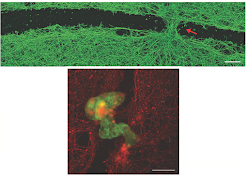Tiny living robots made from human cells surprise scientists
Click on images to enlarge.
In 1920, Czech playwright Karel Čapek wrote a science-fiction play called "R.U.R.", which stood for Rossum's Universal Robots, and which was set in the year 2000. This was the first time the word robot had been used. These robots were more like androids, purely organic beings, instead of metallic walking computers. However, they looked like the tin man from the Wizard of Oz. Engineers have since been working on creating microscopic robotic machines to work at the cellular level. But in recent years, scientists have also gone back to the RUR days of organic robots. They are microscopic and composed of living cells. How does that work?
When xenobots were damaged even to the point of being cut nearly in half, they repaired themselves.
But even more amazing is that these clumps of cells were able to reproduce. Instead of just splitting each cell in the cluster, they worked together to gather other cells in the area. Those new clusters became new xenobots that do the same at the "parents". See what the designer has to say:
More recently, in November 2023, the Tufts U researchers have created "anthrobots", which are cell cluster robots made from human cells, specifically adult lung cells. Instead of 3-4 days, these took 7 days before they showed movement. Also, from 2,281 of these, about half consistently don't move at all even after 3 weeks, even though they have cilia. The thing is, since they were from lung tissue, the cilia formed on the inside of the clump like it was the lining of the trachea. By adjusting the chemical composition of the medium they lived on in the Petri dish, the researchers changed that to the outside.
Anthrobots tend to have 4 types of motion: circular, linear, curvilinear, and eclectic. Examples are shown below from the researchers paper.
Anthrobots come in 8 unique cluster shapes, and each is correlated with a certain amount of cilia. What's more, they follow a scratched line in the Petri dish, which might be useful in later medical research if these are used to follow tissue cuts for repair to take place. See below microscopic tracking of the scratch outlined in yellow and the anthrobot path in pink.
Taken to the next level, anthrobots have also been shown to fix damaged nerve tissue by forming "superbot" bridges. In the photos below, the top one shows a bridge formed in a cut. The bottom picture simply shows the superbot in red and nerve tissue in green.
Considering how important it is to repair nerve tissue, which normally is next to impossible, the usefulness of these organic robots is pretty clear.
Here's a nice 5-minute video that summarizes this blog article.







No comments:
Post a Comment